by Smt. Vijayumari -alias Vijayamma
reviewed by Robert Priddy
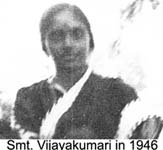
ANYATHA SARANAM NASTHI 'Other than you refuge there is none'
by Smt. Vijayumari -alias Vijayamma
reviewed by Robert Priddy

(Privately published, 1999: Vijamma W/o K.S. HemChand, Opp. Brooke Bond, Main Road, Whitefield, PH #8452553 Bangalore, 560066. India.
e-mail <asn_vijayamma@hotmail.com>)
The most important book from the pro-camp published about Sai Baba since the millennium is surely 'Antatha Saranam Nasti' ('Other than you refuge there is none') by the elderly lady Vijyamma, who was with Baba in his youthful days when the well-known major miracles he reportedly performed reportedly took place. It first came out in Telugu in 1996 & is translated.
Assuming that the personal witnessing of the major miracles recounted were actually experienced by the authoress as described, they often exceed in detail those indirect accounts of Baba's earlier years of Prof. N. Kasturi in his authorised biography of the first 50 years of Baba's life. A variety of other indicators point to the genuineness of the author's memories. The clear dating of visits to - and other contacts with - Sai Baba is helpful and makes clear that the authoress and her family have had a lot of very close access to Baba since October, 1945, even before the opening of the first temple (Paatha mandir). There is no other book in English so far that relates at first hand so many events and meetings with Sai Baba over such a long period of time.
The question of accuracy of these accounts, however, is another matter. One problem of evaluation is - for those readers who are not already convinced followers of Sai Baba as the major divine avatar of the age - the thick layers of devotional praise and encomium which overlay most of her writing. A few samples of the highly imaginative hyperbole: "Sai beamed like the perfect full moon with the sixteen phases shining among the myriad stars, and set out grandly like the sun, the massed divine lustre rising on the Meru Mountain solemly, like a furious elephant!" and "Just like Lord Vishnu, He radiated the brilliance of countless suns."
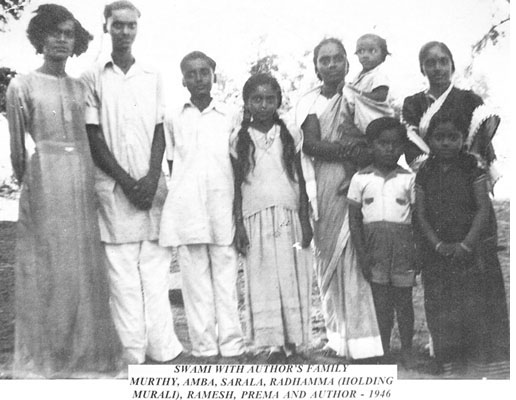
Her devotion is remarkable, but considering the many and sometimes extreme trials through which she was put by Sai Baba, it will be regarded as very misguided by most people who do not need someone to worship. Still, one undoubted value of this book is that the authoress does not flinch - as nearly all devotees do - from telling in credible detail about some of the most deceitful and heartless behaviour by the young Sathya Sai Baba.
When one sees beyond her constant euology and excessive praise for his charisma and charm, she describes an extremely mischievous youth, a rebel against authority who was followed everywhere in Puttaparthi by a 'troop of young monkeys' including herself [and a photograph of the very young Sai Baba together with her family and herself as a young girl proves that she was there]. No one could tell what he would do next, such as talking to elderly people about their sex life and generally acting without regard for people's feelings or any conventions (se some examples in scan at foot of this page).
He has also put his closest followers through terrible difficulties that are interpreted by the faithful as tests of faith or character. He often made close followers tell untruths in which he instructed them, just so to bring out trouble between people!
Some would take this as spiritual teaching, but a more likely interpretation is that he was learning to manipulate others and use the supposed ‘divinity’ which his grandfather, Subamma and superstitious villagers had inculcated into him from his earliest years. One can see that his parents were unable to set boundaries for him and how he was already showing the telltale signs of an ego out of control Vijayamma avoids the 'political correctness' of most followers in her telling how Baba was often very angry and punished people physically, pinching girls and lady's ears often so they were often red, giving cuffs, and inflicting painful pinches of the thighs of boys and men. At the same time, he was able to charm back many of those he offended. This push-pull manipulation of people is a typical trait of the psychopathic personality, and it can be learned very early on by gifted persons of cleverness and charm. It becomes a way of life, and everything is eventually subjugated to extending and reinforcing this power over people. In short, one can interpret his uncontrollable behaviour as that of a budding psychopath, a person with a lot to prove. This can be caused by early traumas of an unknown (possibly sexual) kind and also by often being ostracized and beaten up by other boys (as even and Kasturi reports took place).
Most interesting and rationally challenging is the account of Sai Baba's various exorcisms of possessed persons - mostly women - brought to him before the opening of the new temple in 1940 when he would have been between 16 and 19 years old (since his stated birth year is 3 years later than that recorded by British officialdom). In these exorcisms, he would literally thrash the demons out of them, terrifying all onlookers. This is learned behaviour, of course, for it does not happen where there are no ‘role models’. It is a powerful way of controlling weaker people and creating an aura of mystique around the exorcist, as is also well known to and practiced by many Christian religionists. The young Sathya Sai’s 'victims' were always extremely relieved and grateful afterwards, as also occurs in many exorcisms. The depend on the belief in demons which enter the body of the supposedly ‘possessed’. Asked, "Do demons really exist, Swami?" he replied "Yes! Those who committed suicide, those killed in accidents, those who met with an untimely death, all these will be roaming around like ghosts." (p. 41)
Sathya Sai thrashed a 3-year old boy regularly in his mother's presence! The most telling incidents Vijayamma relates are the treatment meted out to Vijayamma's own well-behaved son at the tender age of three, weekly-repeated physical beatings on his back in view of others for no stated reason or observable fault in the boy. Baba took care of this boy’s education too, and he was a close to him in later life, a fact that may well be interpreted in view of the many accusations of sexual abuse on boys and young men that have surfaced on a wide front since 2000
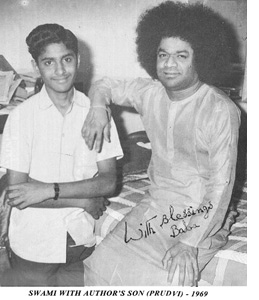
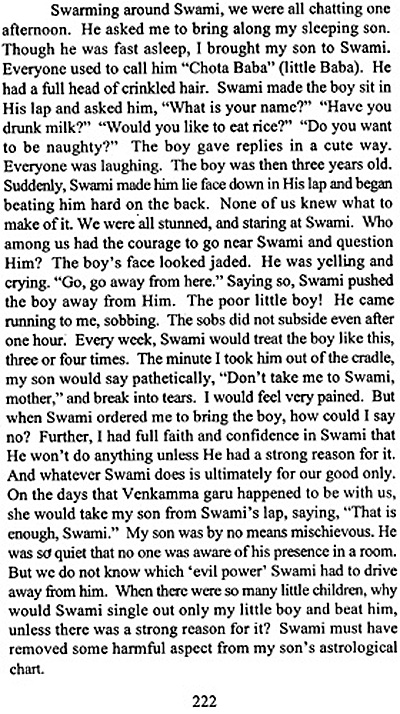
The major miracles allegedly observed by Vijayamma were many and it is curious that she has not published her account before she did, even though she was interviewed at length by Prof. Erlendur Haraldsson in the 1970s. She has said that envy among Sai followers of her and her family was very severe and hard to bear, so this may account for her relative silence. The events she desribes are so far in the past and undocumented and not borne out by other evidence that the accuracy of her subjective accounts must be in considerable doubt, also due to her totally uncritical and rationalizing apologism. Unfortunately, in his book 'Miracles are My Visiting Cards', Prof. Haraldsson appears to have reproduced many of her claims without incisive questioning of her claims nor offering any critical analysis or direct supporting evidence for her testimony.
See excerpts from her book on this and a discussion of them by a Swedish psychologist
and Samsioe's discussion of narcissism and Sathya Sai Baba's personality
In the book, 'Other than You refuge there is none' (Anyatha Saranam Nasthi) by Smt. Vijaya Kumari, who was with Sathya Sai Baba already in the 1940s when he was in his teens, we also read (p. 194-5):
"Krishna was very mild-mannered. He was not brisk, but very slow while walking. He was slim and fair, and of a sensitive temperament. Everyone would tease him saying that he should have been born a lady. While walking with him, Swami would stay very close to him. It showed how much Swami liked him. Looking at them both, we would playfully refer to them as Radha and Krishna. We do not know what merit accrued from previous lives it was that gave Krishna the privilege of staying upstairs in the company of Swami. Because Krishna was fond of bed coffee, Swami himself would make sure that the tray with coffee and biscuits was ready, and then wake him up. His meals also were with Swami. Making Krishna sit by His side serving him items from His own plate, Swami would watch over him very affectionately.
Who will have such rare fortune! Once Krishna had to go to Madras on some errand. Swami developed high fever. In His delirium, He would call out ' Krishna '. His fever subsided only after Krishna returned. This shows how much God loves His devotees..."
... or how much God thinks about some of his male devotees (above all the young, beautiful one with feminine appearance). As far as I know, I have never read anything similar about any female devotee. Is it only male devotees that have gathered up merits from past lives, that makes them targets for Sai Baba's grace?"
One has to admit, this also underpins the descriptions by so many young men who convincingly detail how they were sexually molested by Sai Baba. It also reminds of what Terry Gallagher, the long-term devotee and Australian Central Coordinator who resigned, wrote about how his observations and information led him to investigate, especially that: "relating to students being sexually interfered with in grotesque ways by Sai Baba. It wasn't until 1993, following the assassination attempt on Sai Baba, resulting in the murder of four college students and two assistants in the Mandir, that we made our last visit to India. The purpose of this visit was to find the reason why former students of Sai Baba's college would want to kill him, particularly when they had been given a free education! I made further inquiries about Sai Baba having sexual relations with college boys and male students –and whether this was the reason for former students wanting to kill him. I was told, to my horror, that this was an acceptable Indian practice!"
EXCERPTS FROM 'OTHER THAN YOU REFUGE THERE IS NONE' which illustrates the near-hysterically worshipful attitude of the writer. Note Sathya Sai Baba's acceptance of female-like garb, with a non-male robe, a blue veil, necklaces made him look like a female goddess - Jaganmohini - reputedly the most beautiful of women sent to bewitch the asuras in the Ramayana mythology:-
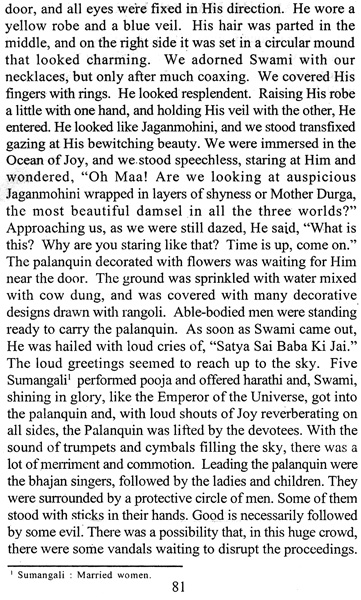
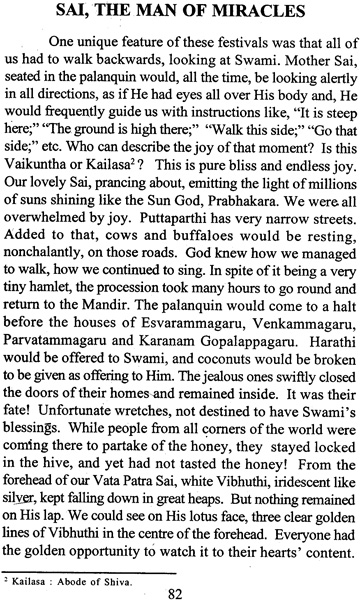
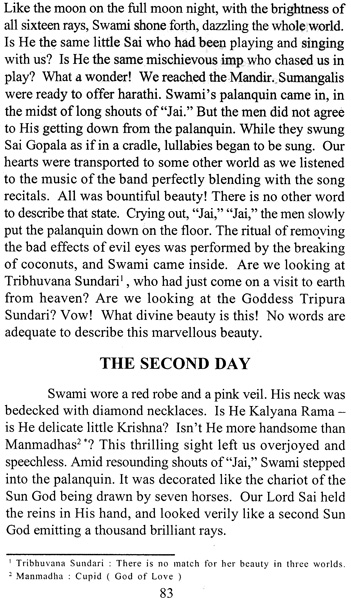
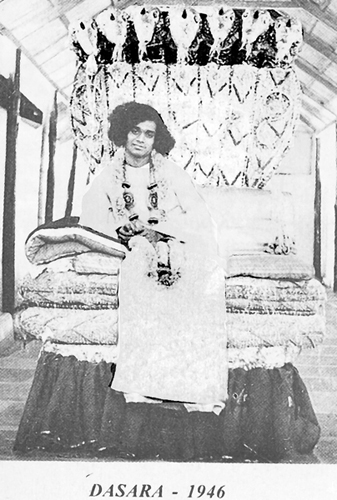
Sathya was clearly already beyond normal social standards even when he was very young, and this surely came of the belief in - and being treated as - a divinity from the very start. At best, only close relatives might have corrected such a person, and even then not fot long in Sathya's case. Few outsiders would risk the wrath of a possible divinity or even of those in their village who zealously regarded him as one. He grew up without notable parental or even school control, no genuine respect for his elders, and a complete lack of behavioural boundaries (which is also often most confusing for a child, who then seeks to push hard to find where the boundary for his behaviour lies. But in Sathya's case he met none. This is a classic element in the forming of a narcissistic and psychopathic personality!

The above indicates a lack of respect for people's feelings and dignity and are mischief of a rather childish kind (for a 20-year old) which almost only devotees projecting divinity into him could take as pranks or 'divine mischief'. Sathya Sai Baba continued with disrespectful behaviour throughout his life in interviews and even in public at darshan. His discourses often contain ridicule of entire classes of people and professions, as well as person who can be identified. He was clearly already beyond normal social limits when he was very young, and this surely comes of his being perceived as - and treated as - a divinity from the very start. The reason for so many around him to be so convinced of this are obscure, but he can have had a phsyical abnormality that made him see to be a divinity (as many born in India with certain most unusual physical features are even today).
No one can correct such a person, except perhaps the parents for some years - and even then not long in Sathya's case. Outsiders would not dare to risk the wrath of a reputed divinity or even of those who regarded him as one. So he grew up without normal lessons of politeness in all situations, any genuine respect for elders, and a complete lack of boundaries (which is also often most confusing for a child, who then seeks to find where the boundary for his behaviour lies. But in Sathya's case he met none. This is the classic making of a narcissistic and psychopathic mind! Psychologists consider much similar uncontrollable 'superior' behaviour as a sign of inferiority feelings having a lot to prove (or to revenge) Someone who has a deep sense of hurt to overcome and seeking ways to get his own back by contriving to rise above others and make them subservient to him. It can be reinforced by early traumas of some (often sexual) kind and not least from being ostracized and beaten up by other boys. That this was so even in his boyhood because of homosexual tendencies he showed was testified in a video clip from the film “Sai Baba - Strange Avatar” (Ireland 1996).
In a video clip from the film “Strange Avatar”, an Indian professor Gnanasakarin, former Lecturer of Engineering at Sathya Sai Univrersity, describes how shepherds he met who knew Sathya Sai Baba in his childhood reported that he was already sexually invasive of other boys private parts.
Transcript of the brief video clip:
“I met one of the shepherds up in the mountain and they were chums of Sathya Sai Baba when he was growing up and they used to say how poor the family as at the time and the other kids around the town used to tease him a lot, Sathya Sai Baba. Even in those days when he was young he used to touch boys in places – very strange places. Sometimes they used to beat him up also. And he would just walk out because he can’t stand up against them. A boy like that would do anything to gain respect in the crowd. So one day suppose he kind of produces something out of thin air. “Ah. Sathya did something, what did you do, what did you do?” And I think that’s how he got started and then he started working pretty good.”
This testimony can be seen on a clip from the film here
The entire film Strange Avatar can be viewed here.